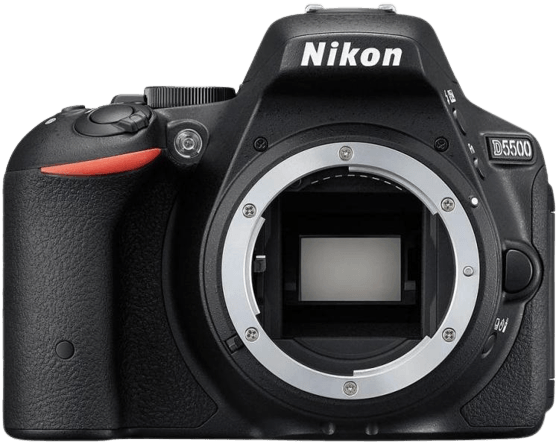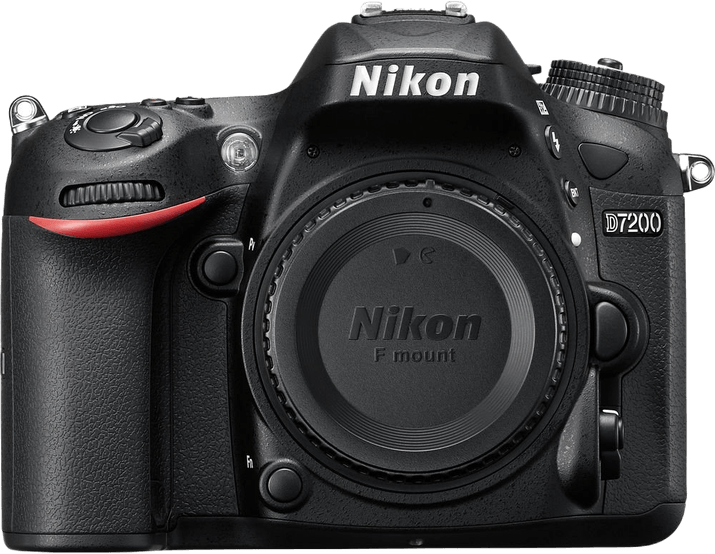Nikon D5500 vs D7200 Comparison
Nikon D5500

Nikon D7200

The Nikon D7200 emerges as the winner with a score of 68/100, compared to the Nikon D5500‘s 61/100. Both cameras are DSLR models released in 2015, with the D7200 announced on March 2nd and the D5500 on January 6th. They share common specifications such as camera type and release year.
The D7200 outperforms the D5500 in several aspects, justifying its higher launch price of $1200 compared to the D5500’s $900. However, the D5500 has a slight advantage in terms of size and weight, measuring 124 x 97 x 70mm and weighing 420g, making it more compact and portable than the D7200, which measures 136 x 107 x 76mm and weighs 765g.
Taking all factors into account, the Nikon D7200 is the superior camera due to its better performance, while the Nikon D5500 offers a more lightweight and compact option for those prioritizing portability.
Nikon D5500 vs D7200 Overview and Optics
The Nikon D7200 outperforms the Nikon D5500 in optics, with a score of 71/100 compared to the D5500’s score of 65/100. Both cameras share several common specifications, such as 24.2 megapixels, a CMOS sensor type, the Expeed 4 processor, an APS-C sensor size, a Nikon F DX lens mount, and no image stabilization.
The D7200 has a higher DXOMARK score for its sensor, at 87 compared to the D5500’s 84, which indicates better overall image quality. Additionally, the D7200 has a faster shooting speed of 6 frames per second, compared to the D5500’s 5 frames per second. This makes the D7200 more suitable for capturing fast-moving subjects and action shots.
On the other hand, the D5500 has its advantages. Although the D7200 has a higher overall optics score, the D5500 is still a capable camera in terms of image quality and performance. The D5500 may be more suitable for photographers who prioritize a lighter and more compact camera, as it is smaller and weighs less than the D7200.
In comparing the optics of the Nikon D5500 and D7200, the D7200 is the superior choice due to its better image quality and faster shooting speed. However, the D5500 remains a viable option for photographers who prefer a smaller, lighter camera without sacrificing too much in terms of performance. Ultimately, the choice between these two cameras will depend on the individual photographer’s priorities and preferences.
Nikon D5500 vs D7200 Video Performance
When comparing the video capabilities of the Nikon D5500 and the Nikon D7200, both cameras tie with a score of 70 out of 100. This equal score indicates that they have similar video features and performance.
The Nikon D5500 and D7200 share several common video specifications, such as Full HD maximum video resolution, 1920 x 1080 video dimensions, and a maximum video frame rate of 60 frames per second. Additionally, both cameras have built-in time-lapse functionality, which is a useful feature for creating dynamic video content.
Despite the tied scores, there are areas in which one camera excels over the other. For the Nikon D5500, its lighter weight and smaller size make it more convenient for handheld video shooting and travel purposes. This advantage may be appealing to users who prioritize portability and ease of use when capturing video content.
On the other hand, the Nikon D7200 offers better low-light performance, which is valuable for shooting video in dimly lit environments or during nighttime. This advantage allows users to capture high-quality video footage in a wider range of lighting conditions.
In the end, both cameras have their unique strengths in video capabilities. The Nikon D5500 is better suited for users who prioritize portability and ease of use, while the Nikon D7200 is a better choice for those who require enhanced low-light performance. Ultimately, the choice between these two cameras will depend on the individual’s specific video needs and preferences.
Nikon D5500 vs D7200 Features and Benefits
The Nikon D5500 and Nikon D7200 both have a feature score of 59/100. These cameras share several specifications, including a 3.2-inch screen, the absence of GPS and Bluetooth, and the presence of Wi-Fi connectivity.
The Nikon D5500 outperforms the D7200 in terms of screen functionality. It is equipped with a touchscreen, allowing for easier navigation and control. Additionally, the D5500 has a flip screen, which enables users to capture images from various angles without difficulty. These features make the D5500 more user-friendly and versatile for photographers.
On the other hand, the Nikon D7200 excels in screen resolution, boasting 1,228,800 dots compared to the D5500’s 1,037,000 dots. This higher resolution provides a sharper and clearer display, which is beneficial when reviewing images and focusing on details. Despite lacking a touchscreen and flip screen, the D7200’s superior screen resolution enhances the overall user experience.
While both cameras have their strengths, the choice between the Nikon D5500 and D7200 depends on individual preferences and priorities. Photographers who value user-friendly features and versatility may prefer the D5500, with its touchscreen and flip screen. Conversely, those who prioritize image review and detail may find the D7200’s higher screen resolution more appealing. Ultimately, both cameras offer unique advantages that cater to different needs and preferences, and the decision rests on what features are most important to the user.
Nikon D5500 vs D7200 Storage and Battery
The Nikon D7200 outperforms the Nikon D5500 in storage and battery, scoring 79/100 compared to the D5500’s 35/100. Both cameras share similarities, such as accepting SD, SDHC, and SDXC memory cards and lacking USB charging capabilities.
The D7200 excels with its two memory card slots, providing more storage options and flexibility for photographers. Additionally, the D7200 offers a longer battery life of 1,110 shots, compared to the D5500’s 820 shots, thanks to its EN-EL15 battery type. This allows users to capture more images without worrying about running out of power.
On the other hand, the D5500 does not offer any significant advantages in terms of storage and battery. Its single memory card slot and shorter battery life, powered by an EN-EL14 battery, make it less convenient for extended shooting sessions.
Considering these factors, the Nikon D7200 is the superior choice for those prioritizing storage and battery capabilities, while the Nikon D5500 may be suitable for casual users who do not require extended battery life or additional storage options.
Nikon D5500 vs D7200 Alternatives
Still not sure which camera is right for you? These related camera comparisons may inspire you:
